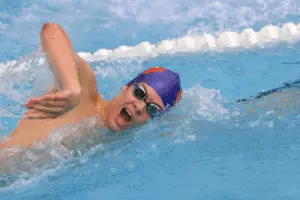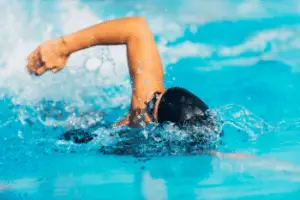Swimming is a great skill to learn and safely helps us take part in many water sports and recreational activities. Whether you are swimming as a form of exercise or just for fun, you may need to be in the water for a long time. It can be exhausting to swim for long periods, and it is helpful to learn ways to swim without reaching your point of fatigue and exhaustion.
Learn The Proper Breathing Technique
 The first thing anyone learns when they begin swimming is how to hold their breath underwater. However, very few people take the time to learn how to breathe when swimming. It is a crucial part of swimming and must be understood if you want to swim for a long time.
The first thing anyone learns when they begin swimming is how to hold their breath underwater. However, very few people take the time to learn how to breathe when swimming. It is a crucial part of swimming and must be understood if you want to swim for a long time.
Swimming requires the use of virtually all the muscles in your body. Accordingly, that will require a lot of oxygenation and thus a lot of breathing. If you’re doing it wrong, your muscles will not get enough oxygen to facilitate movement, and you will inevitably reach the point of exhaustion faster.
Before we get into how to breathe in or out, remember that holding your breath underwater is not breathing. It will waste precious time that you could have used for inhalation or exhalation.
Inhalation
You should be inhaling using your mouth for the entire duration your head is out of the water. For example, if you are swimming freestyle, you would inhale at every turn of your head when given a chance. You can’t inhale underwater, so keep the inhalation part of your breathing out of the water.
Exhalation
There are no consequences to breathing out underwater. Just as you would inhale when your head is out of the water, try only to exhale when you’re underwater. A common method to control your exhalation is to blow small bubbles in the water. It helps you control your breathing more efficiently and stay relaxed. This is also known as trickle breathing. Remember that a flustered and panicked breath is not a controlled breath.
Proper Posture Is Everything
Many amateur swimmers never learn the correct position their body should be in when they are swimming. Proper posture helps you swim more efficiently and control your movement more accurately.
Improper posture underwater creates excess drag. This means that swimming with your body positioned incorrectly causes you to exert a lot more energy to fight against that drag.
The proper body position for swimming is a lot like a correct body posture: your body should almost be in a straight line. Most beginner swimmers tend to swim with their legs sinking below their chest. Try to keep your entire body level and parallel to the water’s surface. It’s easy to achieve this by imagining someone holding you up from your stomach.
Pace Yourself When Swimming
 Just as you, when running, try to pace yourself. If you start out too fast, your muscles will give up sooner. Try to always be swimming less than your full capacity to save your muscles from fatigue (and cramps).
Just as you, when running, try to pace yourself. If you start out too fast, your muscles will give up sooner. Try to always be swimming less than your full capacity to save your muscles from fatigue (and cramps).
As kids, we’ve all heard the fable telling us of the tortoise and the hare. The same principle applies to swimming. Start out swimming slightly slower than your top speed, and continue at that pace, to continue without getting too exhausted.
Your top speed should be reserved for short bursts of swimming and not for long hours of swimming. If you use too much energy at the start of your swim, the end will inevitably be slow.
Slowly Increase Your Endurance
Also, be honest with yourself about your capability and limits. If you’ve been a couch potato for months, don’t expect to be able to swim marathons suddenly. Build up your stamina to give your muscles time to adjust to the appropriate activity level.
During training, you can try to split your swim into parts and take a break as needed. For example, instead of trying to tackle 800 meters in one go, start with 4 x 200 meters with breaks in between. Once you are comfortable swimming at that level, push yourself by swimming two 400 meter laps. Soon enough, you will find yourself swimming your target (800 meters) with ease.
Try not to push yourself too hard. Even Olympic athletes need to train when preparing for an event to increase their endurance levels. They may be doing it at a higher level than you are, but the same principle applies.
Don’t Skimp On Your Strokes
Moving your body in the water is all about getting the most out of your strokes, especially for long-distance swimming. Try to reach out as far as you are physically capable during your strokes. This means that you are swimming further with each stroke and ultimately expend less energy by performing fewer strokes.
In short, longer strokes are a way of increasing the efficiency of your swimming technique. They allow you to propel forward faster, so always reach out as far forward as you can. Proper swimming posture is also important in increasing your stroke length.
Focus On Your Health And Swim More
This final piece of advice is a little obvious. If you swim more, you will improve your cardiovascular health, even if you’re swimming incorrectly. As your muscles get used to exerting the energy required for swimming, they will slowly get more conditioned to that level of activity. You can still snorkel even if you can’t swim, so don’t worry about it!
Also, if you are serious about swimming, you may want to think about nutrition and rest. If you are not eating a healthy diet and not sleeping adequately, do not expect to work wonders in the swimming pool. A healthy, balanced diet is an important part of general health and will help you get to the endurance level you need to swim for long periods without tiring.
You can also use other forms of aerobic exercise to help improve your heart, lung, and muscle health, which in turn allows you to swim without getting tired. Try running, jogging, or even jumping jacks. A healthier and more fit person will generally be able to endure longer swimming times.
Swimming without getting tired is very challenging just like staying warm in cold water without a wetsuit. There are different methods that we need to know in order to overcome these challenges.
